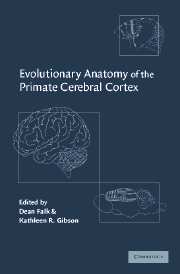Book contents
- Frontmatter
- Contents
- List of contributors
- Preface
- Prologue: Size matters and function counts
- Part I The evolution of brain size
- Part II Neurological substrates of species-specific adaptations
- Introduction to Part II
- 7 The discovery of cerebral diversity: an unwelcome scientific revolution
- 8 Pheromonal communication and socialization
- 9 Revisiting australopithecine visual striate cortex: newer data from chimpanzee and human brains suggest it could have been reduced during australopithecine times
- 10 Structural symmetries and asymmetries in human and chimpanzee brains
- 11 Language areas of the hominoid brain: a dynamic communicative shift on the upper east side planum
- 12 The promise and the peril in hominin brain evolution
- 13 Advances in the study of hominoid brain evolution: magnetic resonance imaging (MRI) and 3-D reconstruction
- 14 Exo-and endocranial morphometrics in mid-Pleistocene and modern humans
- Epilogue: The study of primate brain evolution: where do we go from here?
- Index
13 - Advances in the study of hominoid brain evolution: magnetic resonance imaging (MRI) and 3-D reconstruction
Published online by Cambridge University Press: 07 October 2011
- Frontmatter
- Contents
- List of contributors
- Preface
- Prologue: Size matters and function counts
- Part I The evolution of brain size
- Part II Neurological substrates of species-specific adaptations
- Introduction to Part II
- 7 The discovery of cerebral diversity: an unwelcome scientific revolution
- 8 Pheromonal communication and socialization
- 9 Revisiting australopithecine visual striate cortex: newer data from chimpanzee and human brains suggest it could have been reduced during australopithecine times
- 10 Structural symmetries and asymmetries in human and chimpanzee brains
- 11 Language areas of the hominoid brain: a dynamic communicative shift on the upper east side planum
- 12 The promise and the peril in hominin brain evolution
- 13 Advances in the study of hominoid brain evolution: magnetic resonance imaging (MRI) and 3-D reconstruction
- 14 Exo-and endocranial morphometrics in mid-Pleistocene and modern humans
- Epilogue: The study of primate brain evolution: where do we go from here?
- Index
Summary
Original comparative data on the brains of apes are scarce. The study of the evolution of the human brain and the human mind depends largely on the availability of such evidence. Are there certain features or aspects of the organization of various components of the brain that can be identified as uniquely human? What kind of reorganization took place in the neural circuitry of the hominid brain after the split from other hominoids? How can species-specific adaptations in behavior and cognition be recognized in the underlying neural substrates?
Recent advances in non-invasive neuroimaging techniques used for the analysis of brain structures in vivo in humans can now also be applied to the comparative study of the extant hominoids. Magnetic resonance imaging (MRI) and 3-D reconstruction allow for the identification and quantification of many neural structures across species. Use of living subjects avoids issues of shrinkage involved in postmortem tissue processing, facilitates the study of larger samples and also permits the study of species chronically underrepresented (e.g. bonobos, gorillas, orangutans). These new techniques allow for the quantification of selected lobes and smaller sectors of the brain as well as for a more accurate analysis of sulcal and gyral patterns.
The anatomy of the human brain has been traditionally studied either on gross postmortem specimens or in processed histological sections under the microscope. Attempts to image the living brain used, until recently, conventional radiography, a technique that relied on the differential absorption of X-rays by different components of the brain and its covers.
- Type
- Chapter
- Information
- Evolutionary Anatomy of the Primate Cerebral Cortex , pp. 257 - 289Publisher: Cambridge University PressPrint publication year: 2001
- 5
- Cited by



